Downwinders at Risk
Want to Send Dallas City Hall a Message? Claudia Meyer For Dallas City Council
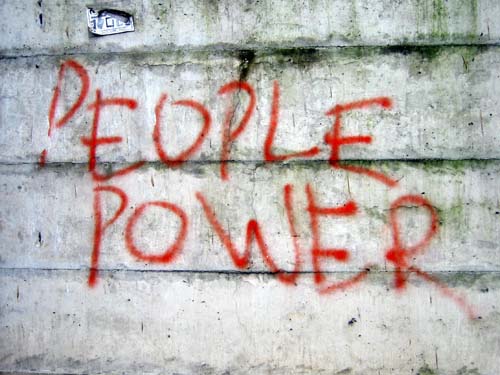 As hard as it is to believe, despite everything that's happened, Dallas could wind up with a more pro-drilling City Council in May than it has right now. Angela Hunt is term-limited. Scott Griggs is being paired with another incumbent, Della Jasso, and one of them won't be back. That's two out of the three major drilling opponents. Only Sandy Greyson is safe.
As hard as it is to believe, despite everything that's happened, Dallas could wind up with a more pro-drilling City Council in May than it has right now. Angela Hunt is term-limited. Scott Griggs is being paired with another incumbent, Della Jasso, and one of them won't be back. That's two out of the three major drilling opponents. Only Sandy Greyson is safe.
That's why it's important to look at the only Dallas City Council race that pits a grassroots environmental leader of the drilling fight against an over-the-top supporter of more drilling – Claudia Meyer vs. Vonciel Hill in District 3, a new district that includes much of Griggs' Oak Cliff and Southwest Dallas turf along with precincts from Hill's old District 5.
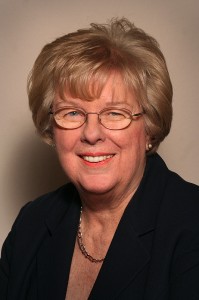 You know Claudia, even if you haven't met her personally – because she's one of you. She's a 20-year Dallas resident, who along with her husband Ed, was there at the very beginning of the Dallas fight four years ago. Like so many others, curiosity about a proposed well near her neighborhood initialed research and activism that continues today. She attended every single Dallas Gas Drilling Task Force Meeting. She's a co-founder of Dallas Residents at Risk. And if that's isn't enough bone fides for you, she's also an original Downwinder, a veteran of the TXI hazardous waste fight of the 1990's.
You know Claudia, even if you haven't met her personally – because she's one of you. She's a 20-year Dallas resident, who along with her husband Ed, was there at the very beginning of the Dallas fight four years ago. Like so many others, curiosity about a proposed well near her neighborhood initialed research and activism that continues today. She attended every single Dallas Gas Drilling Task Force Meeting. She's a co-founder of Dallas Residents at Risk. And if that's isn't enough bone fides for you, she's also an original Downwinder, a veteran of the TXI hazardous waste fight of the 1990's.
Vonciel Hill is a two-term incumbent who enthusiastically supports gas drilling and has shown a propensity for cronyism in office.
Most recently, you might remember her from her February 27th rant comparing City Manager Mary Suhm to Christ for having to suffer through Angela Hunt's cross-examination of Suhm about the circumstances of the secret agreement between Suhm and Trinity East over their pursuit of gas drilling permits in Dallas. The Dallas Observer's Jim Schutze wrote a column about it the next day headlined: "Vonciel Hill: City Council Member, Prophet, Theologian and Sell-Out:"
Yesterday in a Dallas City Council debate over gas drilling on city parkland, Hill compared council member Angela Hunt to Haman, the killer of Jews and symbol of all evil in the Book of Esther.
Not done yet. Next, Hill compared Dallas City Manager Mary Suhm to Jesus Christ. She predicted that Suhm would one day rise from the dead and enjoy her own personal version of Easter.
Council member Hunt had questioned City Manager Suhm sharply over a deception Suhm pulled on the council in 2008, promising to fight against gas drilling on parkland, then secretly signing a deal with a gas company saying she would win them permission to drill on parkland, then taking a $19 million check from them, on behalf of the city, in return for the deal that she hid for years from the council and from the public until Hunt and council member Scott Griggs got onto it recently.
"Recall in the story of Esther how Haman built the gallows for Mordecai, but it was Haman who hanged on the gallows. Those who affix the gallows for you may themselves hang on those gallows.
"And then reach forward from the Hebrew scriptures to the New Testament scriptures, where those who said of Jesus Christ on Good Friday, 'Well, he's done, he's dead, we've got him now,' wait three days, because Easter will come and there will be the resurrection. And those who pierced him on Good Friday are no longer known, and their names are not around, but two thousand and some years later, the name of the Christ is still ringing forth.
"Miss Suhm, this is a Good Friday moment, but I guarantee you from the faith well into which I reach, your Easter is coming, and you will sail forth."
One last thing about this. Since Hill is the one who chose to put the gas drilling debate on these terms, I think it's fair for me to turn it around and ask her a question on the same terms. And this is not a joke.
If Jesus Christ had signed a secret covenant with the Romans agreeing to look the other way while they screwed over the Jews, would we remember his name today? Really? Or wouldn't he have been just one more forgotten cheap politician who took on all sorts of cheap gaudy religious airs in order to pump up his profile? Like you, Ms. Hill. Exactly like you.
 So many people were disgusted by her performance that day that Claudia was overwhelmed by requests to run against Hill. At the last minute, Claudia said yes.
So many people were disgusted by her performance that day that Claudia was overwhelmed by requests to run against Hill. At the last minute, Claudia said yes.
This race is now the necessary next step in the Dallas Drilling Fight. The stakes are very high. If Claudia runs and doesn't win, it not only sets the cause back, but residents could very well have a Dallas city council that will be more pro-drilling than now.
Claudia starts out in a familiar place: underfunded and overworked. That's why she's asking for your help. She's requesting that you please go to her website contribution page right now and send her some needed cash. She needs to raise $9,000 by the end of the first week in April to be able to run the campaign she needs to run to win. Do this today if you want to send City Hall a message that you will continue to fight its drilling plans.
Claudia also needs volunteers to help block walk and make telephone calls, and deliver yard signs. She needs the same army that shows up at City Hall to show up in District 3 to carry the day. Send an e-mail to elect.claudiameyer@gmail.com and let them know you want to volunteer for the campaign. Do it today please.
Remember how you're always saying you'd really like to work for a candidate you believe in? Remember saying how you wish you could send those so-and-so's down at City Hall a real sign of how you feel? The time is now. The opportunity is an e-mail away. In these campaigns, every day is like a week. Don't waste any time. Don't put it off. Or come May, you may find yourself with a City Council that wants to Drill, Baby Drill.
We Have a Winner
 With all the commotion last week over the Dallas drilling vote, we were negligent in covering the 2013 Green Source DFW Awards for Environmental Leadership reception in Deep Ellum. This is a great annual event organized by the Memnosyne Institute that manages to assemble most of the area's environmental groups and personalities without a call to action for any crisis, only an evening of relaxed peer engagement. It's a small but significant sign that there is some infrastructure to the movement.
With all the commotion last week over the Dallas drilling vote, we were negligent in covering the 2013 Green Source DFW Awards for Environmental Leadership reception in Deep Ellum. This is a great annual event organized by the Memnosyne Institute that manages to assemble most of the area's environmental groups and personalities without a call to action for any crisis, only an evening of relaxed peer engagement. It's a small but significant sign that there is some infrastructure to the movement.
This year, Molly Rooke, a Downwinder board member and 25-year volunteer for the Sierra Club, won Volunteer of the Year. Molly has been active on clean air issues since 1988. She's a veteran of the TXI hazardous waste-burning fight of the 1990's and early oughts. Recognition for her contribution was long overdue.
Friends of Tandy Hills (think "Prairiefest" ) won Grassroots Non-Profit Group, as a going away present for founder Don Young, who's moving to Marfa, Deborah Branch of Keep Forth Worth Beautiful won the Non-profit Professional of the year, Frito Lay won the Corporate award and Recycle Revolution won in the Entrepreneur category. Congrats to all the winners and thanks to the folks at Memnosyne for hosting.
Big Day in Big D Drilling Fight: DMN Comes Out Swinging, and Claudia Meyer Will Take On Vonciel Hill for Council Seat
 It's hard to put Wednesday's Dallas City Council meeting into words. The level of aggressive ignorance reached heretofore unknown oxygen-gasping altitudes, as a City Manager who intentionally deceived the Council and public for at least five years was compared to Jesus, and meddlesome residents were castigated for being impediments to the real job at hand – draining city "wasteland" of its gas resources.
It's hard to put Wednesday's Dallas City Council meeting into words. The level of aggressive ignorance reached heretofore unknown oxygen-gasping altitudes, as a City Manager who intentionally deceived the Council and public for at least five years was compared to Jesus, and meddlesome residents were castigated for being impediments to the real job at hand – draining city "wasteland" of its gas resources.
Save for a Perry Mason-worthy cross-examination of City Manager Mary Suhm by Council member Angela Hunt with back-up by Scott Griggs and Sandy Greyson, citizens looking for some accountability for the lack of disclosure over a side deal with industry, or how parkland that was never slated for drilling suddenly landed on a list of drill sites, were left very disappointed.
But professional journalists are paid to write about such things no matter how hard it is to capture the depth of obliviousness, shallowness, and empty-headedness. And If you haven't already, you need to read two published accounts that will send you reeling. One is Jim Schutze's take in the Dallas Observer. The other is today's surprisingly strong Dallas Morning News editorial. We urge you to leave an online comment in support of this editorial, as it's one of the most remarkable the News has ever published. That in itself should indicate how bad Wednesday was – even the Morning News, defender of the Dallas Establishment, was appalled.
As Schutze points out, the most over-the-top and vicious diatribe belonged to current Council member Vonciel Hill, who wrapped herself in self-righteous religious language in condemning fellow council member Angela Hunt and praising the City Manager. From her skewed point of view, it was Mary Suhm who had been outrageously wronged, and Hunt who was at fault for even questioning the integrity of a person who would engage in obviously unimportant things like secret agreements with industry, and misleading statements.
That's why we're very encouraged to hear the news this morning that longtime neighborhood advocate and clean air supporter Claudia Meyer is filing to run against Vonciel Hill in the newly-created District 3 that covers southwest Dallas. Claudia is a former Assisted Living facility director and medical social worker who's lived with her husband in the same Mountain Creek home for over 30 years. She’s been a well-known neighborhood advocate as a board member of both the Fox Hollow Homeowners Association and Mountain Creek Neighborhood Alliance. She also has a long history of volunteer public service on behalf of the community including membership on the boards of the Friends of Mountain Creek Library, Friends of Fox Hollow Park, and the Dallas Municipal Library Board.
But most people reading this will instantly recognize her as the motherly-figure that has guided Dallas neighborhood resistance to irresponsible gas drilling for the last four years. She and her husband Ed have been a fixture at every official meeting where gas permits have been discussed since 2009. They also happen to be longtime Downwinders, having come on board during the 1990's TXI hazardous waste burning fight.
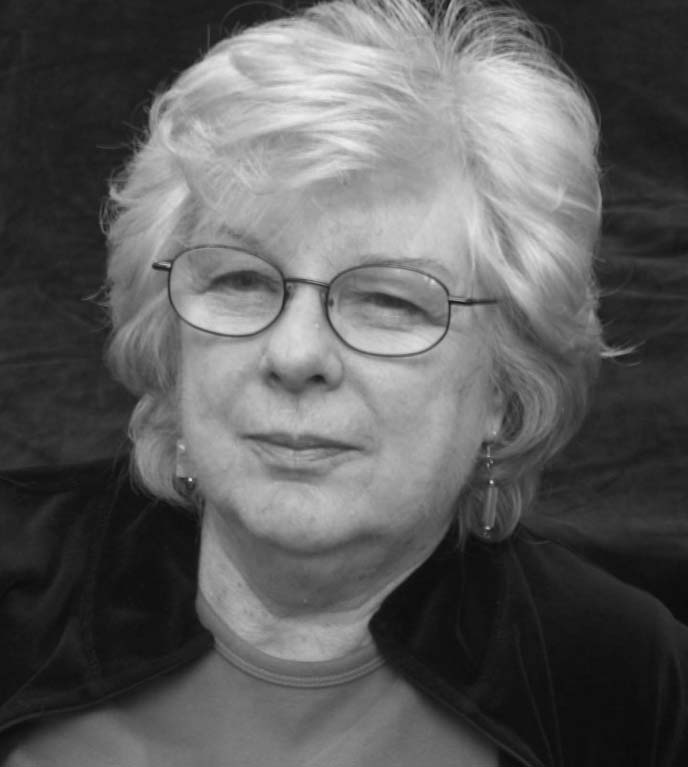 Given the tone of the Dallas City Council on Wednesday, symbolized by Vonciel Hill's speechifying, electing Claudia Meyer may be that the most important thing any Dallas area person who calls him or herself an environmentalist can do for the local biosphere between now and June. Why? Defeat of Hill would strike at the heart of the drilling-at-all-costs faction of the Council, and just might provide a one-vote margin for denying all three Trinity East gas permits, including the refinery/compressor station that will become Dallas' 10th largest air polluter in Dallas the moment it comes online. Moreover, along with Scott Griggs and Sandy Greyson, Claudia could be a strong voice for a greener, more citizen-friendly Dallas in general. That's why the North Dallas-based Citizens Council will probably be spending a lot of money trying to re-elect Hill.
Given the tone of the Dallas City Council on Wednesday, symbolized by Vonciel Hill's speechifying, electing Claudia Meyer may be that the most important thing any Dallas area person who calls him or herself an environmentalist can do for the local biosphere between now and June. Why? Defeat of Hill would strike at the heart of the drilling-at-all-costs faction of the Council, and just might provide a one-vote margin for denying all three Trinity East gas permits, including the refinery/compressor station that will become Dallas' 10th largest air polluter in Dallas the moment it comes online. Moreover, along with Scott Griggs and Sandy Greyson, Claudia could be a strong voice for a greener, more citizen-friendly Dallas in general. That's why the North Dallas-based Citizens Council will probably be spending a lot of money trying to re-elect Hill.
We'll continue to try and help you educate yourselves about candidate choices, so that you'll when you step into the booth and pull the lever, you'll know who best answers the question: "In your opinion, If Jesus was the City Manager of Dallas, would he make secret deals with gas companies and be hankering to drill on park land?"
Finally, today folks begin arriving for the national fracking conference taking place on Saturday and Sunday at the Best Western Plus Dallas Hotel & Conference Center at 8051 Lyndon B Johnson Freeway just east of Coit (map). The line-up for speakers on Sunday is particularly stellar, as we wrote about last week – three national speakers you don't get to hear in the same place on the same day very often.
And if you want the Dallas City Council to know exactly how you feel about its performance on Wednesday, you can join members of the nationally known "Light Brigade" for an evening protest on Saturday beginning at 6:30 at the hotel. These folks use LED lights to make short "freeway blogger" type messages that thousands of people end up seeing. Very effective use of new technology. Saturday's message will be "No Fracking" and they'll be close enough to LBJ to make an impact. You can learn more about them here at their Facebook page.
What Wednesday made clear is that we have a lot of work left to do, and that this is now a defining moment in Dallas civic history. We have the power to shape it, but we all must now commit to not only talking the talk, but walking the walk – block by block.
Another Win for Your Lake of Air
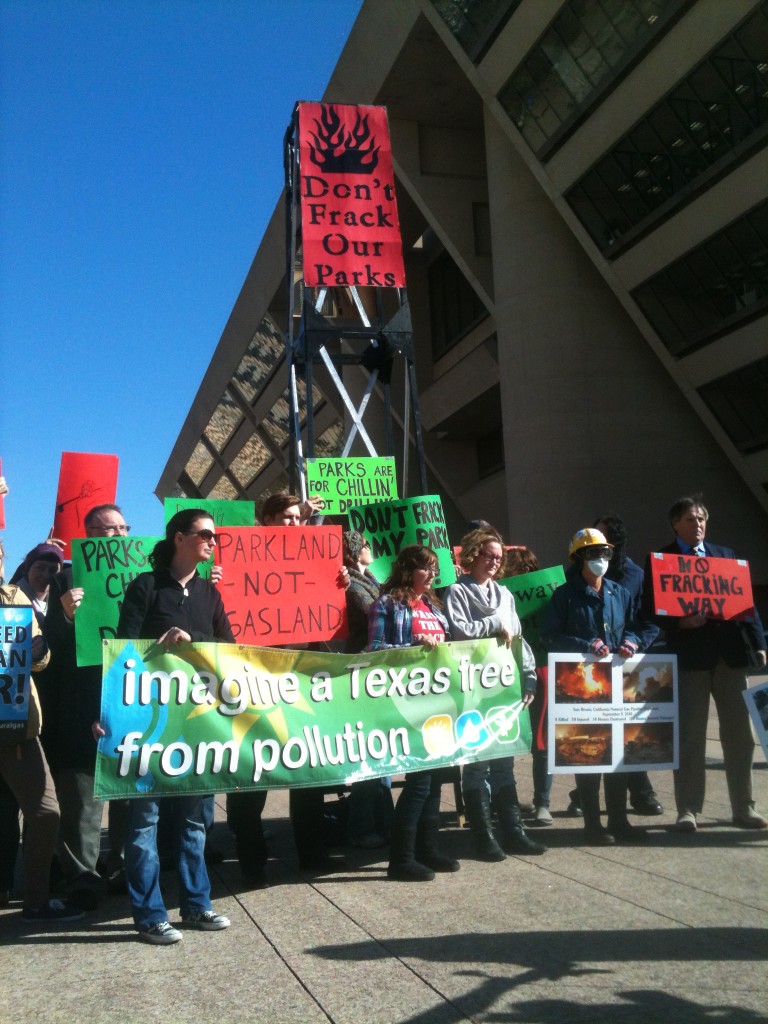 Late Thursday night Downwinders at Risk, as part of the Dallas Residents at Risk alliance, won a victory that citizens weren't supposed to win. Late Thursday night Downwinders at Risk, as part of the Dallas Residents at Risk alliance, won a victory that citizens weren't supposed to win.
Immediately after Thanksgiving, Dallas Mayor Mike Rawlings and City Manger Mary Suhm had plotted to speed the approval of the first gas drilling permit in Dallas. One left over from 2008 that would be exempt from the new drilling ordinance now in the works. One that included a compressor station and allowed for the drilling in city parks and flood plains. City Hall believed it had greased the tracks with threats of gas company lawsuits and given the City Plan Commission no choice but to approve the permit. Just to be sure, they scheduled the Plan Commission vote for December 20th, a time guaranteed to result in smaller crowds of opposition at City Hall. But something happened to make things go a little off-script. Responding to calls for help, enough Dallas residents showed up to articulately speak against the permit for more than an hour. They represented hundreds of neighborhood groups, the environmental community and public interest organizations like the League of Women Voters. If the raw numbers didn't match earlier attendance, the people that did show up represented real constituencies numbering in the thousands. When the vote was finally called at 7:30 pm Thursday evening, we won 7 to 5. The "grandfathered" gas drilling permit would not be approved by the Plan commission. To overturn this decision, the City Council must find 12 votes – a super majority – in favor of the permit at its mid-January meeting. This was not the result Dallas City Hall was counting on the Thursday night before Christmas. But thanks to supporters like you, it was the result that happened. Just as we mobilized opposition to Midlothian cement plant pollution, and helped organize Frisco residents to close down an obsolete and dangerous lead smelter, Downwinders is drawing a line in the Shale in Dallas and leading a push back against irresponsible urban drilling. And, against very long odds, we're winning….again. We do this to protect your lake of air. You ingest an average of 200 gallons of water every year, or about five bathtubs' worth. But you inhale approximately two million gallons of air every year – your own small lake of air.
In DFW, chances are your lake of air is going to have smog in it, along with some soot, some Sulfur Dioxide, Volatile Organic Compounds, as well as an assortment of other manufactured If your tap water was dirty brown and had lots of particles in it, you'd probably choose to drink bottled water. But when the air is dirty brown and has lots of particles in it, your lungs don't have a choice about the air they can use. Downwinders at Risk is here for one reason and one reason only: to defend your lake of air. Whether your air is threatened by smelters, gas rigs, cement plants or too-common smog, we're working to clean it up. For our efforts, Downwinders was proud to receive the first-ever GreenSource DFW award for Outstanding Grassroots Group in 2012. Looking ahead to 2013, your lake of air faces new threats, including worsening new permits by the Midlothian cement plants to burn large volumes of industrial garbage, and indiscriminate aerial spraying of pesticides by local governments. Downwinders at Risk will fight these threats with the combination of good science and citizen activism that's made us the foremost clean air group in DFW. But we need your help to do it. Our work depends on contributions from folks like you who appreciate what we do. Our annual budget is usually only around $30-50,000. We do all the work we do with an amount of money larger groups spend annually on office furniture or travel. We don't get money from a parent group in Washington or New York. Our board members are all from DFW. They're ordinary citizens like you, not rich patrons. Small donations make up a very large percentage of what we take in every year. We couldn't do what we do without you. In the time it took you to read this message, you've inhaled a couple of more gallons of air. Don't you think it should be clean air? You keep supporting us; we keep working for you – and surprising the opposition with victories that citizens in Texas just aren't supposed to be able to pull-off. That's our promise. Thanks for your consideration and Please click here to safely and securely donate online, or send checks to Downwinders at Risk, PO Box 763844, Dallas, TX 75376. Your donation is greatly appreciated and will be wisely spent. Thanks.
|
Hell Freezes Over: Why the New Federal Report on Midlothian Matters
Everything in italics and "quotation marks" below is a direct quote from the latest chapter of the ATSDR's (Agency for Disease Registry and Toxic Substances) "health consultation" on the impact of certain kinds of industrial air pollution on the local population.
You should take five minutes to glance over the sentences. They've taken a better part of a decade and a great deal of citizen persistence to make it to print. You can read them now only because of a petition to ATSDR by local Midlothian residents, spearheaded by Sal and Grace Mier in 2005, prompted the Agency to get involved.
They're also rarer than hen's teeth. Because the words actually come together in sentences to conclude human health was likely harmed by the pollution from Midlothian's three cement plants and steel mill, as well as recommend decreasing that pollution.
Among grassroots activists, ATSDR has a notorious reputation for issuing reports that are "inconclusive by design." The joke is that the agency never met a facility it couldn't learn to live with. And sure enough, previous chapters in this saga have disappointed. Just two years ago, ASTDR's shoddy work in investigating health impacts in Midlothian and elsewhere across the country was the subject of a Congressional hearing.
These ATSDR reports generate no new data. Instead, they are retrospective looks back at the available sampling/monitoring information and a piecing together of possible exposure paths and levels. As such, they're only as good as the data they can digest. In Midlothian's case, that means they're completely dependent on state monitoring – criticized by citizens for years as being inadequate. Nevertheless, with this latest report, citizens have been somewhat vindicated because of what even that inferior sampling revealed.
The health impacts described in this latest report are also limited to what are called "Criteria Pollutants" – old school substances like lead, soot, sulfur dioxide, and ozone that have been regulated by the Clean Air Act for decades. They do not apply to more exotic kinds of air pollution like endocrine disruptors, which there's little or no monitoring for at all.
So there are a lot of missing pieces, but the ATSDR's conclusions and recommendations have an impact on your lungs and maybe your own local fight, even if you don't have a Midlothian zip code. For the first time a federal agency known to avoid coming to any conclusion about anything was forced to say that human health was adversely affected by the operations of industry in Midlothian.
There's a public meeting on this report on December 6th from 7 to 8:30 pm at the Midlothian Conference Center.
Health Consultation/Assessing the Public Health Implications of the Criteria (NAAQS) Air Pollutants and Hydrogen Sulfide MIDLOTHIAN AREA AIR QUALITY MIDLOTHIAN, ELLIS COUNTY, TEXAS
NOVEMBER 16, 2012 U.S. DEPARTMENT OF HEALTH AND HUMAN SERVICES
Agency for Toxic Substances and Disease Registry
Division of Community Health Investigations
Recommendations:
"Texas Commission on Environmental Quality (TCEQ) should take actions to reduce future SO2 emissions from TXI to prevent harmful exposures."
"TCEQ should take actions to reduce future PM2.5 emissions from TXI and Gerdau to prevent harmful exposures."
"TCEQ should continue efforts to reduce regional ozone exposures."
"TCEQ should insure that levels of these air pollutants do not increase to levels of concern in the future."
"TCEQ should conduct ambient air monitoring to characterize exposures to persons located downwind of the Ash Grove and Holcim facilities and take actions to reduce SO2 emissions from these facilities if harmful exposures are indicated."
"TCEQ should conduct appropriate ambient air monitoring to characterize exposures to persons located downwind of the Ash Grove and Holcim facilities and take actions to reduce PM2.5 emissions from these facilities if harmful exposures are indicated. In addition, particulate matter monitoring is needed in residential areas that are in immediate proximity to the facilities’ limestone quarries."
"In ATSDR’s judgment, one notable gap in monitor placement is the lack of monitoring data for residential neighborhoods in immediate proximity to the four industrial facilities, where fugitive emissions (those not accounted for in stack emissions) likely have the greatest air quality impacts."
Human health was likely harmed, and is still threatened by industrial pollution from Midlothian
From Sulfur Dioxide:
"Breathing air contaminated with sulfur dioxide (downwind of TXI's cement plant and the Ameristeel steel mill) for short periods could have harmed the health of sensitive individuals.…ATSDR cannot determine if harmful exposures to SO2 have been occurring downwind of the Holcim and Ash Grove facilities."
"All 24-hour values in Midlothian were lower than EPA’s former standard. However, the World Health Organization’s health comparable guideline is 8 ppb (WHO, 2006). This value was exceeded at both the Midlothian Tower and Old Fort Worth Road stations in most years of monitoring through 2008…"
"Overall, in the years 1999 to 2001, Old Fort Worth Road (monitoring site north of TXI) ranked among the stations with the highest 24-hour average sulfur dioxide concentrations in the state. As sulfur dioxide emissions from TXI Operations decreased in following years, so did the measured concentrations at this station."
From Particulate Matter, or Soot:
"Public health concern is warranted for adverse health effects from long-term exposure to PM 2.5 in Cement Valley"
"In the past (1996–2008), annual average PM 2.5 levels measured were just below the range of concentration proposed by EPA for lowering the annual average standard…Moreover, many of the annual average PM 2.5 concentrations were above the more conservative WHO health guideline (10 μg/m3)."
"No PM 2.5 monitoring data are available to evaluate exposures downwind of the Ash Grove facility. Furthermore, although annual average PM2.5 levels detected at the Holcim monitor indicate possible harmful levels…."
"We estimated that annual average PM2.5 levels in the vicinity of the Gerdau Ameristeel monitor, from 1996 to 1998, could have ranged from about 22.6 to 26.4 μg/m3, which is above both the current and proposed EPA standard. Using EPA’s approach, the 3-year average level might have been above the NAAQS standard of 15 μg/m3 for these years in the vicinity of the Gerdau Ameristeel monitor. Applying this same approach to annual average PM10 data from other monitors suggests that PM 2.5 levels could have been close to the current and proposed PM2.5 standard, especially for the Wyatt Road, Old Fort Worth Road, Gorman Road, and Midlothian Tower monitors."
"Consistent with the other pollutants discussed earlier, the estimated annual PM 2.5 emissions listed for these facilities are among the highest for Ellis County and also rank high among industrial sources statewide."
From Lead:
"Past lead air exposures during the period 1993 to 1998, in a localized area just north of the Gerdau Ameristeel fence line, could have harmed the health of children who resided or frequently played in this area….In the mid-1990s, the lead levels measured in this area ranked among the highest lead concentrations measured statewide."
From Smog:
"Scientific studies indicate that breathing air containing ozone at concentrations similar to those detected in Midlothian can reduce lung function and increase respiratory symptoms, thereby aggravating asthma or other respiratory conditions. Ozone exposure also has been associated with increased susceptibility to respiratory infections, medication use by persons with asthma, doctor’s visits, and emergency department and hospital admissions for individuals with respiratory disease. Ozone exposure also might contribute to premature death, especially in people with heart and lung disease. School absenteeism and cardiac-related effects may occur, and persons with asthma might experience greater and more serious responses to ozone that last longer than responses among people without asthma."
"The Midlothian Tower site recorded ozone concentrations above the level of the NAAQS for several years (TCEQ, 2011b), and the Old Fort Worth Road site has been measuring ozone concentrations close to the level of the NAAQS. Based on the data from both monitors, from August 1997 to September 2011, the 8-hour EPA ozone standard has been exceeded 236 times."
From Breathing Multiple Pollutants:
"ATSDR believes that sufficient information exists to warrant concern for multiple air pollutant exposures to sensitive individuals, especially in the past….The ability of the scientific community to fully and quantitatively evaluate the health effects from the mixture of air pollutants people are exposed to is at least ten years away (Mauderly et al., 2010)……The current state of the science limits our ability to make definitive conclusions on the significance of simultaneous exposures to multiple criteria air pollutants. ATSDR’s conclusions are based on our best professional judgment related to our understanding of the possible harmful effects of air pollutant exposures in Midlothian and our interpretation of the current scientific literature; therefore, these conclusions are presented with some uncertainty."
From New Production:
"Reductions in SO2 levels in Cement Valley have occurred since late 2008 resulting in exposures to both sensitive individuals and the general public that are not expected to be harmful. These reductions may be caused, in part, by declining production levels at local industrial facilities. Future harmful exposures in Cement Valley could occur if production rises to at least previous levels and actions are not taken to reduce SO2 emissions."
Regulatory "Safe Levels" Very Often Aren't
"Past SO2 exposures were not above the Environmental Protection Agency (EPA) standard in place at that time but were above the current standard."
"Past lead air exposures were not above the EPA standard at that time but were above the current standard.…The scientific community now believes that the current standard (15 μg/m3) for fine PM (measured by PM2.5) is a better indicator of possible long-term health effects from PM exposures than was the former EPA annual average standard for PM10 (EPA, 2006b)."
2nd TCEQ Clean Air Plan in Four Years Fails, Leaves Air Dirtier
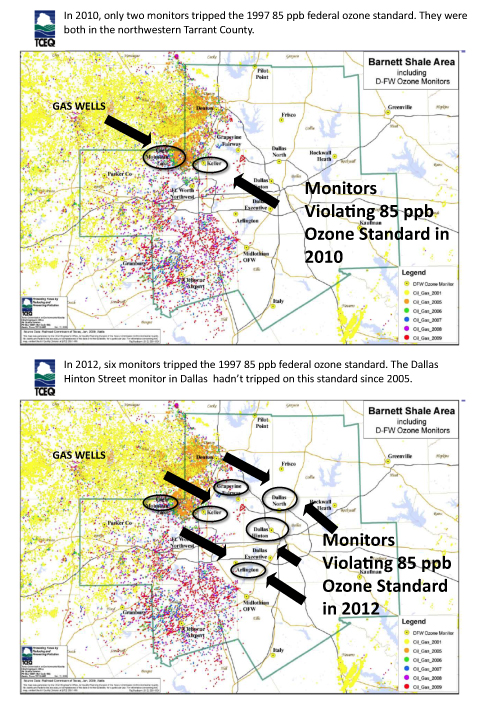 For the second time in four years a state-designed clean air plan to bring safe and legal air to DFW residents has failed, missing its goal by an even wider margin than on its first try, and leaving local air quality worse than when it started.
For the second time in four years a state-designed clean air plan to bring safe and legal air to DFW residents has failed, missing its goal by an even wider margin than on its first try, and leaving local air quality worse than when it started.
November 1st marked the official end of the eight-month 2012 ozone season. According to the Texas Commission on Environmental Quality, or TCEQ, its plan was supposed to deliver record-breaking clean air to DFW this summer on its way to bringing the region into compliance with the Clean Air Act for the first time in two decades.
When the Gas Industry Says “Full Disclosure,” It Only Means 65%
According to an EneryWire analysis, "at least one chemical was kept secret in 65 percent of fracking disclosures" by companies that publicly disclosed the ingredients in their hydraulic fracturing fluid.
 The study supports the claims of critics including Downwinders, that companies who say they're fully disclosing the contents of their fracking fluids aren't really doing so. Downwinders has joined other members of the Dallas Residents at Risk alliance in calling for the City of Dallas to require true full disclosure of all fracking fluids in order to better protect first responders.
The study supports the claims of critics including Downwinders, that companies who say they're fully disclosing the contents of their fracking fluids aren't really doing so. Downwinders has joined other members of the Dallas Residents at Risk alliance in calling for the City of Dallas to require true full disclosure of all fracking fluids in order to better protect first responders.
Industry claims it has a right to prevent the public, including doctors, firefighters, and police from knowing certain "trade secret" ingredients in their fracking fluids and every clearinghouse for ingredient information – including the much-heralded one established in Texas – allows for the use of this exemption. This trade use exemption is what the EnergyWire analysis tracked.
"It's outrageous that citizens are not getting all the information they need about fracking near their homes," said Amy Mall, who tracks drilling issues for the Natural Resources Defense Council. "Companies should not be able to keep secrets about potentially dangerous chemicals they're bringing into communities and injecting into the ground near drinking water."
But companies say they spend millions of dollars researching and developing new formulations of frack fluid and shouldn't have to give away their secret recipes.
"In just the past 18 months, the industry has spearheaded an effort that took us from an idea on paper about disclosure to a fully functional and user-friendly disclosure system," said Steve Everley of Energy in Depth, a campaign of the Independent Petroleum Association of America. "That kind of commitment and progress cannot be overstated in a discussion about industry disclosure."
This is very simple. If your a Dallas firefighter responding to an accident at a gas facility site, you need to know what chemicals are on site, how much of those chemicals are there, and where they're stored. No exceptions.
Welcome to our Remodeled Digs
 We didn't change the dressing on our www window to the world all that much, but we can do a lot more now.
We didn't change the dressing on our www window to the world all that much, but we can do a lot more now.
Like write in paragraphs on the front page without a page jump. it feels good just to…
…..stretch. Not sure who invented paragraphs, but there should be a statue to them somewhere.
This is only the fourth iteration of the Downwinders at Risk website that goes back all the way to 1996. In line with our philosophy, each one has been more participatory than the one before. This WordPress version allows for a lot more multi-media options and interactive features on both ends of the site.
Thanks for being patient over the course of this transition, which took much longer than we anticipated. We hope we can now reward you with better online service.
Downwinders, The Early Years

